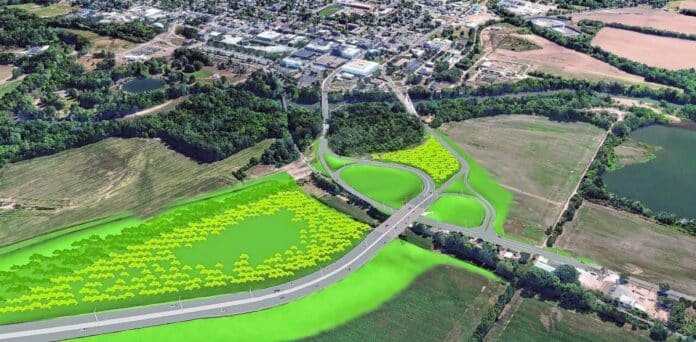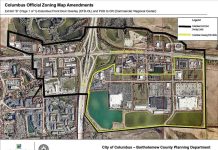
Railroad officials are still projecting an increase in northbound and southbound railroad traffic on the Louisville & Indiana tracks through the State Road 46 and State Road 11 intersection on the city’s west side, but are unsure when the uptick will occur.
Construction crews are now working to build an overpass that will allow motorists to avoid being stopped by trains passing through the high-traffic intersection.
The $35 million project – which is being jointly funded by the Indiana Department of Transportation, city of Columbus, Bartholomew County, Cummins Inc. and the Louisville & Indiana and CSX railroads – is predicated, in large part, on the expectation that railroad traffic will dramatically increase in the future.
Much of that increase in rail traffic has yet to come, according to railroad officials and public records.
[sc:text-divider text-divider-title=”Story continues below gallery” ]Click here to purchase photos from this gallery
Last year, an average of eight trains passed through the intersection per day, but "can vary on a whole multitude of factors" each day, said John Goldman, Louisville & Indiana Railroad president, which owns and operates the railroad line.
That number, however, is less than projections of up to 17 to 22 trains passing through the intersection each day and is the same amount of railroad traffic listed in a 2016 railroad impact study prepared for the city of Columbus.
The latest update on railroad traffic that Louisville & Indiana provided to the Federal Railroad Authority states that six daytime trains and two nighttime trains passed through the intersection on Nov. 22, 2018.
“That’s still the plan, the economy willing,” Goldman said. “It could be as high as (17 trains). It’s hard to tell how long it would take to get to that number. It’s just one of those things, as time goes on and the economy changes, so does rail traffic.”
Goldman said the nearly 40,000 motorists who cross the State Road 46 railroad tracks at State Road 11 could possibly start seeing two to three additional southbound trains at some point this year.
"That is a possibility. If that happens, I don’t think it will happen before the end of the third quarter or sometime in the fourth quarter (of 2020)," he said.
In 2016, a railroad impact study that American Structurepoint Inc. and Policy Analytics LLC prepared for the city of Columbus says there were an average of eight trains passing through the city at the time and estimated that there could be a total of 22 trains per day by 2018, the report states.
The projections are based off a 2013 environmental assessment by the Surface Transportation Board’s Office of Environmental Analysis, the railroad impact study states.
The Surface Transportation Board of the United States is a federal regulator with economic oversight over railroads, including construction, acquisition of rail lines, mergers, among other things.
The environmental report was done by the board as part of the process of reviewing a proposed agreement between CSX Transportation Inc. and Louisville & Indiana Railroad Company to jointly use 106.5 miles of railroad between Louisville and Indianapolis that passes through Columbus.
The Surface Transportation Board report states that says as many as 17 trains could passing through the intersection of State Road 46 and State Road 11 at some point in the future, compared to an average of two trains that were crossing the intersection as of 2013.
The joint-use agreement was approved by the Surface Transportation Board in April 2015, according to public records.
CSX Transportation told federal regulators that if the joint-use agreement was approved, the company planned to move between 13 and 15 trains per day mostly from its Louisville to Cincinnati rail corridor to the Louisville & Indiana Railroad line, according to the environmental assessment.
CSX Transportation committed to $70 million to $90 million in upgrades along the 106.5-mile segment of railroad that would allow for faster and heavier trains.
Louisville & Indiana Railroad Company is a wholly owned subsidiary of Anacostia Rail Holdings, according to the Surface Transportation Board. CSX Transportation is a wholly owned subsidiary of CSX Corp., which owns and operates around 21,000 miles of railroad in the United States and Canada.
CSX officials declined to comment on how many of the company’s trains are running through Columbus or provide updates on the upgrades, referring all questions to Louisville & Indiana Railroad Co.
City officials said they are operating under the assumption that railroad traffic will increase as projected in the coming years.
"They were predicting 17 or 20 more trains per day when they did that environmental study and that was intended to be the maximum. But nobody knew if that was going to happen on day 1 or day 1,001,” said Columbus city engineer Dave Hayward.
"We know there are more trains today than on day 1 when they first signed that agreement," Hayward added.
The railroad overpass project broke ground this past November and, as of late January, INDOT officials estimated the project was on pace to completed by spring 2021.
Goldman said he does not foresee construction on the railroad overpass affecting the amount of rail traffic going through the intersection.
"We will continue to run trains," Goldman said. "We may have to slow down in that area, but we will continue to run trains."
[sc:pullout-title pullout-title=”About the overpass project” ][sc:pullout-text-begin]
Visit columbusrailroadproject.org for more information about the railroad overpass project.
[sc:pullout-text-end]




